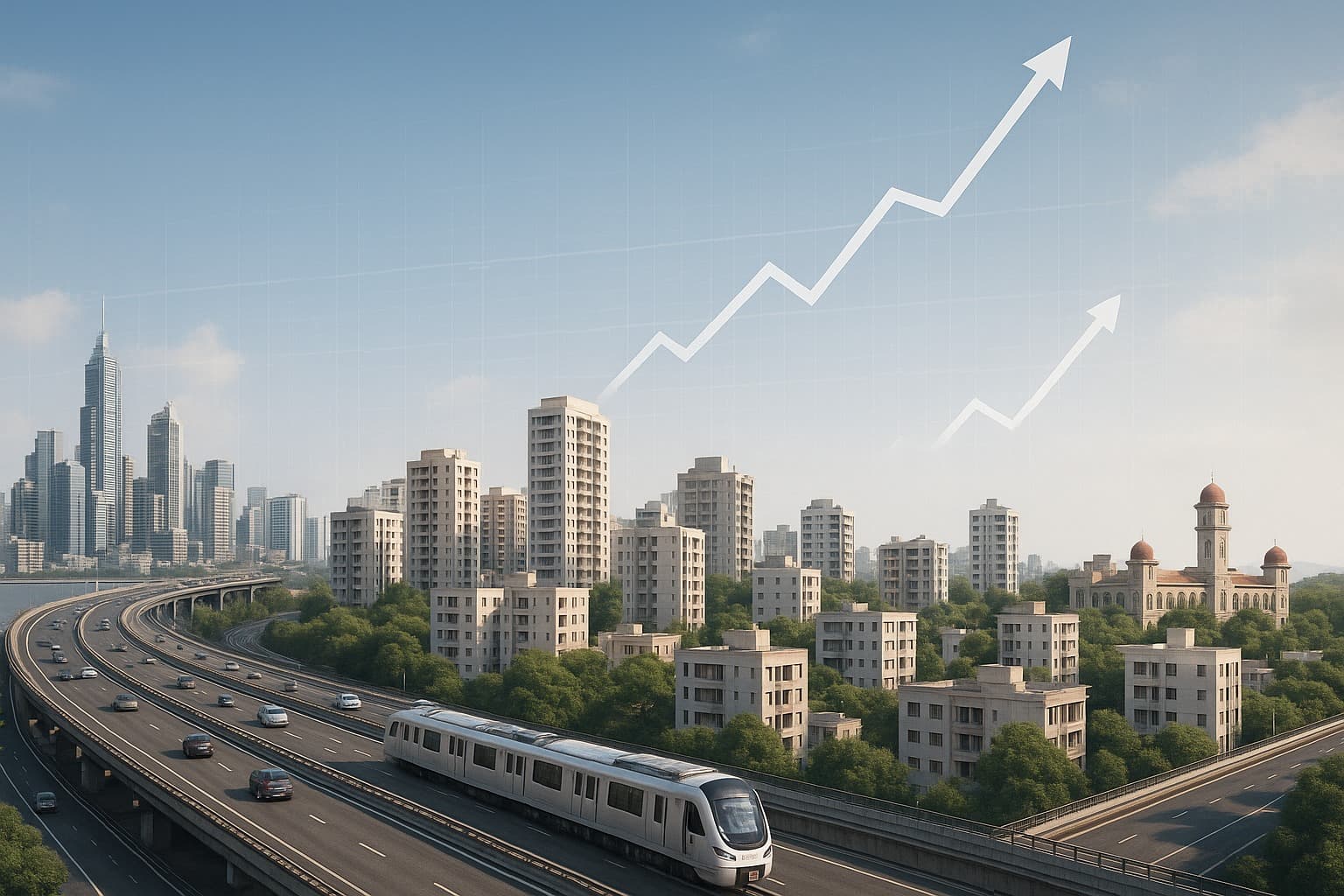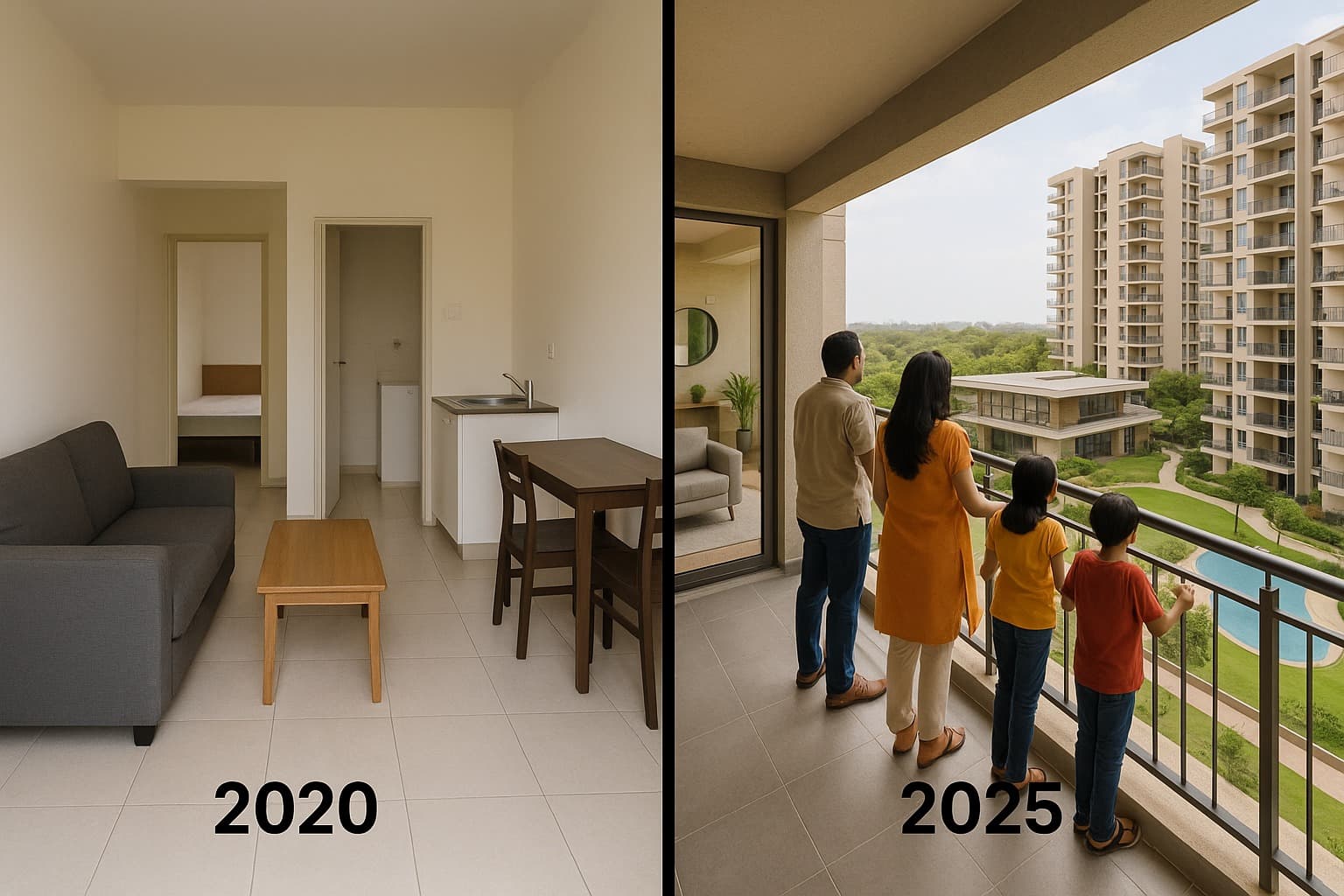Indian Real Estate: A Market Comparison of 2020 vs 2025
Summary
Indian real estate rebounded strongly from 2020 to 2025. 2025 showcases increased demand, rising prices, and renewed confidence compared to 2020's pandemic-driven downturn, marking a resilient recovery.

Real Estate Market Comparison: 2020 vs 2025
Think back to 2020. Life was uncertain, cities were under lockdown, and the Indian housing market felt like it had hit a pause button. Fast-forward to 2025, and the same sector feels alive, buzzing with demand, and more resilient than ever. The real estate comparison between these two years isn’t just about numbers—it’s about how the sector adapted, survived, and came back stronger.
When we look at the property market 2020 vs 2025, the transformation is nothing short of extraordinary. The shift is visible everywhere—from the way homes are bought, to the kinds of properties people prefer, to the pace of real estate growth across cities.
Indian Real Estate Performance 2020 vs 2025
The Indian real estate performance 2020 vs 2025 is like comparing night and day. In 2020, the pandemic froze everything. Construction sites went silent, homebuyers delayed decisions, and sales dropped drastically. Developers offered discounts and flexible payment plans just to keep transactions moving.
But in 2025, the mood has flipped. Developers are announcing record launches, and buyers are queuing up. The trust that wavered in 2020 has returned with full force. Homes are no longer seen just as assets—they’ve become symbols of stability, safety, and future security. That shift explains why sales volumes and launches today far surpass 2020 levels.
Housing Market Comparison Post-Pandemic
The housing market comparison post-pandemic is where the real story lies. In 2020, affordability ruled. People focused on smaller homes that fit tight budgets. Developers even threw in freebies—furniture, modular kitchens, and maintenance waivers—to entice buyers.
By 2025, the trend has changed completely. Homebuyers now prioritize lifestyle. They want bigger apartments, township projects with schools and malls inside, and communities designed for hybrid working. Instead of discounts, demand is pushing prices upward.
This change also reflects how the pandemic permanently altered buyer psychology. Owning a home is no longer just about investment returns—it’s about security and comfort. That explains the strong housing demand and sales trends India 2020 vs 2025.

Property Price Growth India 2025
If 2020 was the year of stagnant prices, 2025 is the year of appreciation. In 2020, values barely moved as developers focused on clearing unsold stock. In contrast, property price growth India 2025 is visible across metros and tier-2 cities.
Bengaluru and Hyderabad lead the charts with double-digit gains, thanks to IT expansion and infrastructure upgrades. Pune has seen steady appreciation along its metro corridors. Even cities like Ahmedabad and Kolkata, often considered slow movers, are now witnessing healthy price growth.
The real estate price appreciation from 2020 to 2025 in metro cities proves that Indian housing has re-entered a strong growth cycle, fueled by both end-user demand and investor confidence.
Indian Property Sales Data 2020 vs 2025
The numbers tell their own story. In 2020, sales in the top cities fell by nearly half compared to 2019. Site visits dropped to historic lows, and the pipeline of new launches slowed dramatically.
Now, look at the Indian property sales data 2020 vs 2025. In just the first half of 2025, sales outpaced the full year of 2020. Unsold inventory has shrunk, and launches are being absorbed faster than ever. NRIs, who were cautious in 2020, are pouring money into India’s real estate again, drawn by stability and attractive returns.
Impact of Pandemic on Indian Real Estate Growth Till 2025
The impact of pandemic on Indian real estate growth till 2025 goes beyond temporary disruptions. It permanently reshaped the way the industry works:
Technology-first approach: Virtual tours, online bookings, and digital documentation are now standard.
Bigger homes in demand: With hybrid work, buyers prefer extra rooms, balconies, and open spaces.
Focus on health and sustainability: Townships with hospitals, green zones, and smart features are attracting families.
Stronger regulations: RERA and reforms have instilled a level of trust that was missing in 2020.
In short, the challenges of 2020 forced the market to adapt, and that adaptation is fueling the success of 2025.
How Indian Property Market Evolved from 2020 to 2025
So, how Indian property market evolved from 2020 to 2025? In simple terms: from hesitation to confidence.
Buyers who delayed decisions in 2020 are now more determined to purchase.
Developers who once focused on quick sales now build long-term integrated projects.
The market shifted from “survival mode” to “growth mode” within five years.
The real estate sector changes in 5 years highlight resilience. Despite inflation and global uncertainties, Indian real estate continues to thrive because it offers something rare: emotional security along with financial stability.

Metro Cities vs Tier-2 Cities: A Balanced Growth
One key takeaway from the real estate market comparison between 2020 and 2025 in India is how growth has balanced out between metros and smaller cities.
Metros like Mumbai and Delhi NCR saw demand push outward into suburbs, supported by metro lines and expressways.
Tier-2 cities like Indore, Lucknow, and Coimbatore gained traction as remote work allowed families to move away from congested metros.
Commercial real estate, once hit hard in 2020, is now recovering strongly with flexible office formats and IT growth.
This balanced demand across city categories ensures that growth isn’t concentrated in just a few regions—it’s nationwide.
Conclusion
The real estate market comparison between 2020 and 2025 in India reveals a sector that not only bounced back but reinvented itself. 2020 was about uncertainty, falling sales, and frozen prices. 2025, on the other hand, reflects recovery, growth, and renewed confidence.
The housing demand and sales trends India 2020 vs 2025 show how much buyer psychology has shifted—from affordability in 2020 to lifestyle upgrades in 2025. The property price growth India 2025 proves that the sector is entering a strong appreciation cycle again.
For investors and end-users alike, the journey from 2020 to 2025 is proof that Indian real estate remains one of the most reliable long-term bets.
Summary (100 words)
The real estate comparison of 2020 vs 2025 showcases the sector’s remarkable turnaround. While 2020 saw uncertainty, low sales, and stagnant prices due to the pandemic, 2025 reflects strong demand, rising prices, and renewed investor confidence. The impact of pandemic on Indian real estate growth till 2025 was significant—it changed buyer preferences, accelerated digital adoption, and built resilience. Today, both metros and tier-2 cities are growing steadily, with end-users and NRIs driving demand. The property market 2020 vs 2025 proves that Indian housing has evolved from hesitation to confidence, making real estate one of the most secure investments in 2025.
